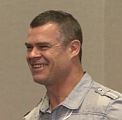DOWNLOAD BEYOND THE GUIDEBOOK 2022: “Because local governments need real numbers to deliver outcomes, we landed on a concept which we call the Riparian Deficit. This is a measure of land use intrusion into the streamside protection zone,” stated Tim Pringle, Chair of the Ecological Accounting Process (released June 2022)

“Now that we have landed on the Riparian Deficit concept, we are able to reflect on the two issues which provided context for the journey: first, engineering measures are insufficient for stream and riparian protection; and secondly, the link to municipal asset management has not been clear. To reach the destination, we had to address and show how to overcome four challenges: one, a lack of measurable metrics; two, confusion over what is an asset versus a service; three, ignorance about how to quantify the financial value of natural assets with real numbers; and four, numerous one-off projects that fail to build improved asset management practice,” stated Tim Pringle.
DOWNLOAD: Stormwater Planning: A Guidebook for British Columbia

“Released in 2002, the Guidebook provides a framework for effective rainwater management throughout the province. This tool for local governments presents a methodology for moving from planning to action that focuses on implementing early action where it is most needed,” states Laura Maclean. “The Guidebook approach is designed to eliminate the root cause of negative ecological and property impacts of rainwater runoff by addressing the complete spectrum of rainfall events. The Guidebook approach contrasts with conventional ‘flows-and-pipes’ stormwater management.”
Water Balance Model – On Tour!

“Have a look at some of the Water Balance Model slideshow presentations that have been made to industry and government groups starting in 2001. This includes some of the early presentations on the Water Balance Methodology that helped pave the way for the paradigm-shift from 'peak flow thinking' to 'volume-based thinking'. The many presentations created awareness and influenced expectations,” stated Ted van der Gulik.
LOOK AT RAINFALL DIFFERENTLY: “Drainage in the context of urban planning and development decisions has historically been an afterthought…let’s just get the water out of here,” stated Hugh Fraser, former Deputy Director of Engineering, City of Delta

“Delta’s rain garden program started with a phone call from Deb Jones, a volunteer with the Cougar Creek Streamkeepers. In 2004, she approached me with a request that the municipality undertake a stormwater pilot infiltration pilot project in North Delta. We identified the opportunity to build the first rain garden at an elementary school. The project was a success and so was the ensuing program. Within the first decade, for example, Delta had constructed a total of 50-plus rain gardens. 10 of these were located at elementary schools,” stated Hugh Fraser.
PRECEDENT FOR AN ECOSYSTEM-BASED APPROACH TO WATERSHED PLANNING: “Passage of the Fish Protection Act in 1997 spawned an array of initiatives, including the Stormwater Planning Guidebook,” stated Kim Stephens, principal author and project manager

“BC communities are experiencing the unintended environmental consequences of policy frameworks that have not been well implemented. But despair not. Knowledge and wisdom that would pull us back from the brink are waiting to be rediscovered and mobilized so that communities can change course in time. Charting a course through perilous waters starts with understanding WHY certain dots from the period 1997 through 2005 are foundational. The Fish Protection Act 1997 is one such dot. Yet this rich history may be largely ignored and/or forgotten,” stated Kim Stephens.
FLASHBACK TO THE 2000s: “The City of Coquitlam turned a crisis into a transformational outcome and emerged as a green infrastructure leader in the Metro Vancouver region,” stated Kim Stephens, Partnership for Water Sustainability

“In 2003, the City was clearly visionary when it first embraced and then formalized a watershed-based approach as a foundation piece in the Official Community Plan. By the latter part of the decade, however, Coquitlam was viewed by others in the region as the example of what not do. A noteworthy aspect of the Coquitlam story is how quickly municipal staff learned from experience, adapted their approach, and successfully instilled a new way of doing business. Coquitlam is the model for keeping things simple, practical, and implementable,’ stated Kim Stephens.
KEEP IT SIMPLE, PRACTICAL AND IMPLEMENTABLE: “If people rely too much on standards, they park their brain at the door. Its much better to think about the principles behind the standards and use judgement in implementing them,” stated Pete Steblin, former City Engineer and City Manager

“When I became City Manager, the City’s approach to watershed-based community planning, rainwater management and green infrastructure was quite idealistic. As a result, the city could not implement what was proposed. We had to do a re-think. That is when we came up with the monicker net environmental benefit. So, what we did was to re-think things and say something is better than nothing. When we made those changes to on-site rainwater management requirements, they were good changes, and they were well received,” stated Pete Steblin.
DESIGN WITH NATURE: “We must do a better job of protecting streams. We are talking about a change in attitude so that communities would view natural systems and water differently. We can turn the situation around,” stated Richard Boase, career environmental champion within local government in the Metro Vancouver region

“We knew more than 20 years ago what we needed to do when designing residential communities, but local governments generally failed to act. Turning the situation around is SIMPLE when you understand hydrology. And when you understand the kinds of changes needed in development practices, and the differences they would make, property to neighhourhood to watershed. We are saying there is a way of designing communities and making decisions differently so that you can be restorative in nature within the urban development context,” stated Richard Boase.
SPONGE INFRASTRUCTURE AND ATMOSPHERIC RIVERS: “Planners are finding clever ways to capture stormwater, treating it as an asset instead of a liability,” wrote Matt Simon after the future fell on Los Angeles in February 2024

“As the American West and other regions dry out, they’re searching for ways to produce more water themselves, instead of importing it by aqueduct,” wrote Matt Simon. “So the old way of stormwater management isn’t just increasingly dangerous and ineffective as the planet warms and storms get more intense—it stands in the way of a more beautiful, less sweltering, more sustainable urban landscape. LA, of all places, is showing the world there’s a better way.”
DESIGN WITH NATURE TO RESTORE STREAM HEALTH: “Streams need a place to be. If we cannot get our heads around that, we are not going to keep our streams,” stated Tim Pringle, Chair of the Ecological Accounting Process Initiative

“Because nature is a system, you cannot slice and dice it. EAP, the Ecological Accounting Process, recognizes this and is a financial tool to give streams the support they need to survive in the local government setting. EAP provides a value picture of a stream system as a land use. The Riparian Areas Protection Regulation enables this approach. The foundational ideas behind what we advocate are IMPLEMENTATION and RESPONSIBILITY. And there is a third idea named OPPORTUNITY,” stated Tim Pringle.
INSTILL A CULTURE THAT SUPPORTS CHAMPIONS: The “blue link” rain garden is symbolic of the transformational change which has taken root in the Township in the 21st century as designing with nature became the ‘new normal’.

Resource protection – for groundwater supply and fisheries habitat – is the original driver for implementing ‘green infrastructure’ in Langley. Township staff have learned and adapted. Langley has led by example and implemented a ‘water balance’ approach to large-scale residential projects. Moving ahead on a ‘green’ platform gained momentum as standard practice evolved through ‘learn by doing’ experience. “The term ‘blue link’ describes the purpose of the current drainage standard in Langley. It replaced the traditional curb-and-gutter detail for all but arterial roadways,” stated Ramin Seifi.
KEEP IT SIMPLE, PRACTICAL AND IMPLEMENTABLE: “Drill down and make your plans as simple as possible. So simple that you could bring multiple, multi-year plans forward at the same time, regardless of the resources you have on hand,” stated Melony Burton, Manager of Infrastructure Planning with the City of Port Coquitlam in Metro Vancouver

“When I looked at the history of the DCC Bylaw updates, staff had tried to take it forward several times. They would almost get to the finish line, then trip and fall. Each time, it seems that they started fresh instead of looking at why the previous attempts had failed. The first thing I did was look at WHY THEY FAILED. They tripped over being too complicated or getting sidetracked. Keeping it simple and basic is what got the DCC Bylaw over the line. In five years, we can update it and make it more complex if we need to. Now we at least have an updated bylaw adopted,” stated Melony Burton.
SOLUTIONS TO COMPLEX PROBLEMS REQUIRE DEEP KNOWLEDGE: “It is mentoring and actively passing on knowledge that allows complex problems to be solved. It will take time. But with a long-term strategy, you will get there,” stated Robert Hicks, a career engineer-planner in local government in the Metro Vancouver region

“The notion of a superficial understanding explains the challenge that I am seeing. There are post-2000 graduate engineers coming out of university who are familiar with green infrastructure ideas and concepts, but they do not know the details behind them: details that they did not have to know at university or in their previous jobs. Sure, they understand rainwater management ideas and concepts at a high level. But without the background and history, can they really appreciate why certain targets and approaches were selected while others were not?” stated Robert Hicks.


